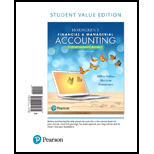
No significant influence equity investments:
These investments are the investments in equity securities where the investor holds less than 20% of the voting stock, and thereby the investor would not be able to participate in the decisions of the investee company. These investments are reported as the current assets or the long-term assets on the basis of the period which the investor holds the investments.
Given:
I Railway will represent 5% of the voting stock of Company P for three months.
To identify: How the given investment would be classified.
Explanation of Solution
When the investor invests in the debt or equity securities, holding less than 20% of the voting stock of the investee company, then such investment is known as no significant influence equity investment.
Hence, the correct answer is option b. no significant influence equity investment.
Justification for incorrect answers:
Option a. Significant interest investments are the equity securities where an investor holds more than 20%, but less than 50% of the voting stocks. Here, Railway I (investor) will own only 5% of the voting stock of Company P. Hence, option a. is incorrect answer.
Option c. Held-to-maturity investment is the investment which is held till their maturity date. Here, Railways I is not planning to hold the investment till maturity, but is planning to hold them for only three months. Hence, option c. is an incorrect answer.
Option d. Controlling interest investments are the equity securities where an investor holds more than 50% of the voting stocks. Here, Railway I will hold only 5% of the voting stock of the investee company. Hence, option d, is an incorrect answer.
Justification for correct answer:
Option b. As the investor company (Railway I) is considering investing in the investee company (Company P) representing less than 20% of the voting stock (5%) of the investee company, then such investment would be classified as a no significant influence equity investment.
Hence, option b. is the correct answer
Want to see more full solutions like this?
Chapter 10 Solutions
Horngren's Financial & Managerial Accounting, The Managerial Chapters, Student Value Edition Plus MyLab Accounting with Pearson eText -- Access Card Package (6th Edition)
- Nonearrow_forwardhi tutor provide answer General accountingarrow_forwardHamilton Corp. recently reported an EBITDA of $18.5 million and a net income of $3.6 million. The company had $2.8 million in interest expense, and its corporate tax rate was 35%. Compute Depreciation and Amortization (D&A).arrow_forward
- Costs of $9,200 were incurred to acquire goods and make them ready for sale. The goods were shipped to the buyer (FOB shipping point) for a cost of $600. Additional necessary costs of $1,300 were incurred to acquire the goods. What is the buyer's total cost of merchandise inventory?arrow_forwardMendoza Company's highest point of total cost was $85,000 in June. Their point of lowest cost was $60,000 in January. The company makes a single product. Production volume in June and January was 16,000 and 9,000 units, respectively. What is the fixed cost per month? Round your final answer to the nearest whole dollar.arrow_forwardI want answerarrow_forward
- The following standards for variable overhead have been established for a company that makes only one product: Standard hours per unit of output 6.6 hours Standard variable overhead rate $13 per hour The following data pertain to operations for the last month: Actual hours 9,800 hours Actual total variable overhead cost $125,210 Actual output 1,460 units Required: A. What is the variable overhead rate variance for the month? B. What is the variable overhead efficiency variance for the month?arrow_forwardWhat is the answer?arrow_forwardFinancial accounting questionarrow_forward

 AccountingAccountingISBN:9781337272094Author:WARREN, Carl S., Reeve, James M., Duchac, Jonathan E.Publisher:Cengage Learning,
AccountingAccountingISBN:9781337272094Author:WARREN, Carl S., Reeve, James M., Duchac, Jonathan E.Publisher:Cengage Learning, Accounting Information SystemsAccountingISBN:9781337619202Author:Hall, James A.Publisher:Cengage Learning,
Accounting Information SystemsAccountingISBN:9781337619202Author:Hall, James A.Publisher:Cengage Learning, Horngren's Cost Accounting: A Managerial Emphasis...AccountingISBN:9780134475585Author:Srikant M. Datar, Madhav V. RajanPublisher:PEARSON
Horngren's Cost Accounting: A Managerial Emphasis...AccountingISBN:9780134475585Author:Srikant M. Datar, Madhav V. RajanPublisher:PEARSON Intermediate AccountingAccountingISBN:9781259722660Author:J. David Spiceland, Mark W. Nelson, Wayne M ThomasPublisher:McGraw-Hill Education
Intermediate AccountingAccountingISBN:9781259722660Author:J. David Spiceland, Mark W. Nelson, Wayne M ThomasPublisher:McGraw-Hill Education Financial and Managerial AccountingAccountingISBN:9781259726705Author:John J Wild, Ken W. Shaw, Barbara Chiappetta Fundamental Accounting PrinciplesPublisher:McGraw-Hill Education
Financial and Managerial AccountingAccountingISBN:9781259726705Author:John J Wild, Ken W. Shaw, Barbara Chiappetta Fundamental Accounting PrinciplesPublisher:McGraw-Hill Education





